This easy classic chicken stock is made from roast chicken carcasses and makes a delicious base for all sorts of soups, casseroles and other dishes.

Homemade chicken stock
Sometimes the old ways are the best. If you want a really good stock with no odd additives and plenty of flavour, it’s well worth making your own.
See also
- Slow cooker chicken stock is an alternative method, ideal for the crockpot.
- You can also make pressure cooker chicken stock.
- All my best leftover chicken recipes – delicious ways to use your leftover cooked chicken
Good chicken stock is a kitchen essential. I do use stock cubes and pots from time to time, and some of these are really quite good, though they tend to go heavy on the salt, which can be a nuisance. Sometimes, however, only a proper homemade stock will do.
Far from being an indulgence, making your own stock is proper waste not, want not home economy. If you enjoy a roast dinner at the weekend, why would you let anything go to waste? This chicken stock is easy to make and easy to incorporate into all sorts of dishes.
Indeed, stock is everything in cooking, at least in French cooking. Without it, nothing can be done. If one’s stock is good, what remains of the work is easy; if, on the other hand, it is bad or merely mediocre, it is quite hopeless to expect anything approaching a satisfactory result.
Auguste Escoffier, Basic Elements of Fine Cookery
This recipe makes 4–5 jars of richly flavoured chicken stock that sets to a jelly in the jar, as a good homemade stock should do.
You can buy chicken pieces to make stock, but a good cook wastes nothing with flavour, so I use a roast chicken carcass. It seems an unnecessary expense and a waste to buy chicken just for stock.
It is, however, absolutely not worth the effort of making stock from just one carcass, so you need to save them up. Whenever we have roast chicken, I strip the carcass but don’t worry about getting every last bit of meat off. Then I break up the body of the chicken and pack it all into a bag in the freezer.
Enough is enough
Once you have three large or four small chickens, it is time to make your stock. It’s enough but not too much.
In a restaurant kitchen, stock is made in a huge pot on the stove where it bubbles all day. I certainly don’t need that much. Who needs a pot of stock they can’t physically lift? Or a gallon of stock in a domestic kitchen?
I use a good heavy casserole dish or Dutch oven, with a well fitted lid (this helps to prevent your entire home smelling of stock). You can make your stock on the stove top but I like it to simmer in a low oven to avoid the smell becoming too pervasive.
Why make chicken stock?
- It’s frugal
- It makes everything more delicious
- Avoids food waste
- Completely natural
- No salt!
Classic chicken stock ingredients
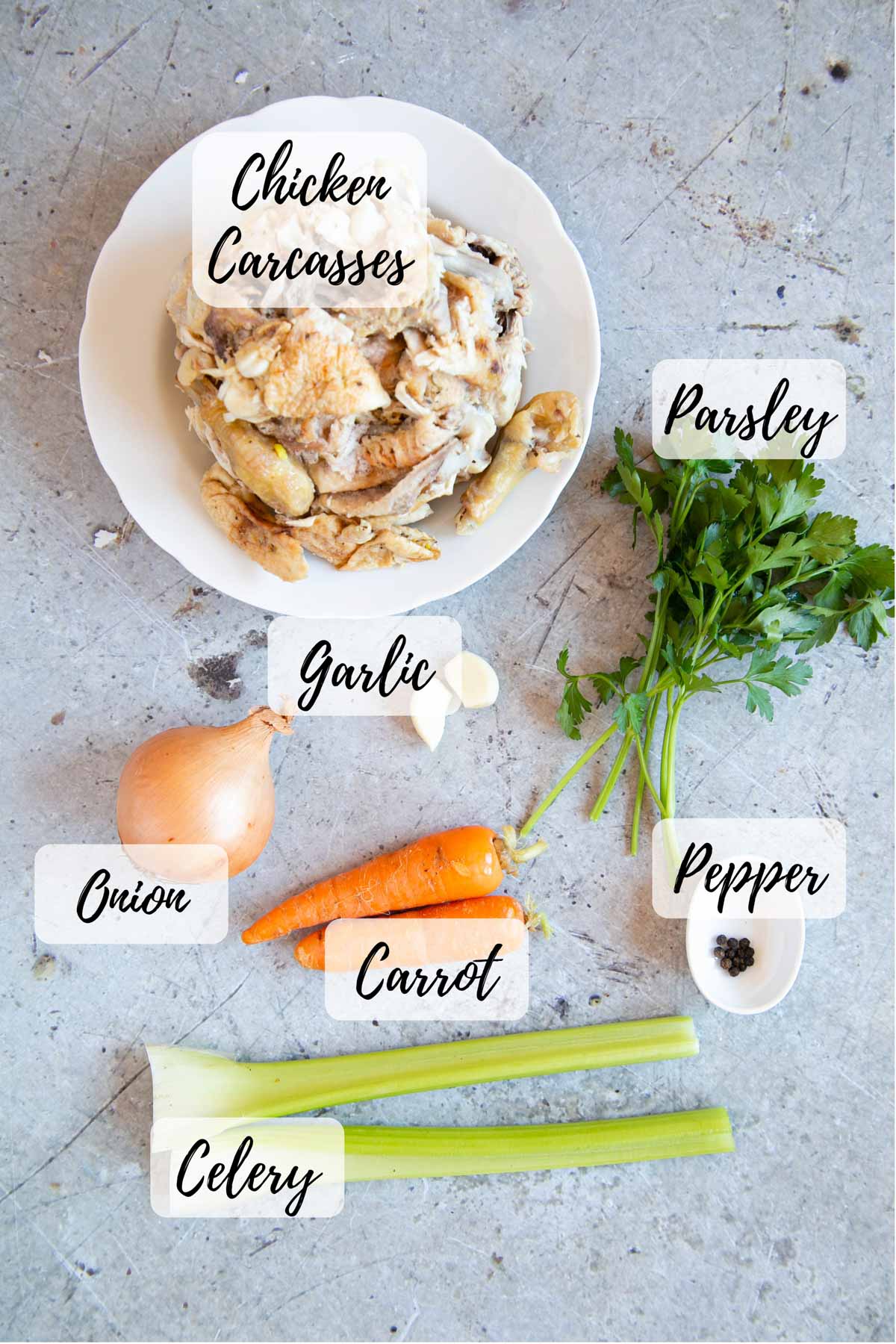
- Roast chicken carcasses – three or four. Break them up and keep in the freezer until you have enough.
- Celery, carrots and onion – the classic soffrito/mirepoix mix. Wash the vegetables. You don’t need to peel them.
- Garlic – no need to peel
- Parsley – the fresher cut, the better, but in winter or if you can’t grow your own, buy a bunch from the supermarket and stand it in water in the fridge.
- Pepper – a few black peppercorns
What, no salt?
No! Getting the salt right in a recipe is a delicate balance. Many commercial stock cubes can cause you to inadvertently over-salt a dish and spoil it. This chicken stock does not need salt. It is an ingredient. When you use it, you can season the whole dish precisely and to taste.
This means my classic chicken stock is ideal for those on a low sodium diet.
How to make chicken stock – step by step
Before you start, read my step-by-step instructions, with photos, hints and tips so you can make this perfectly every time.
Scroll down for the recipe card with quantities and more tips at the bottom of the page.
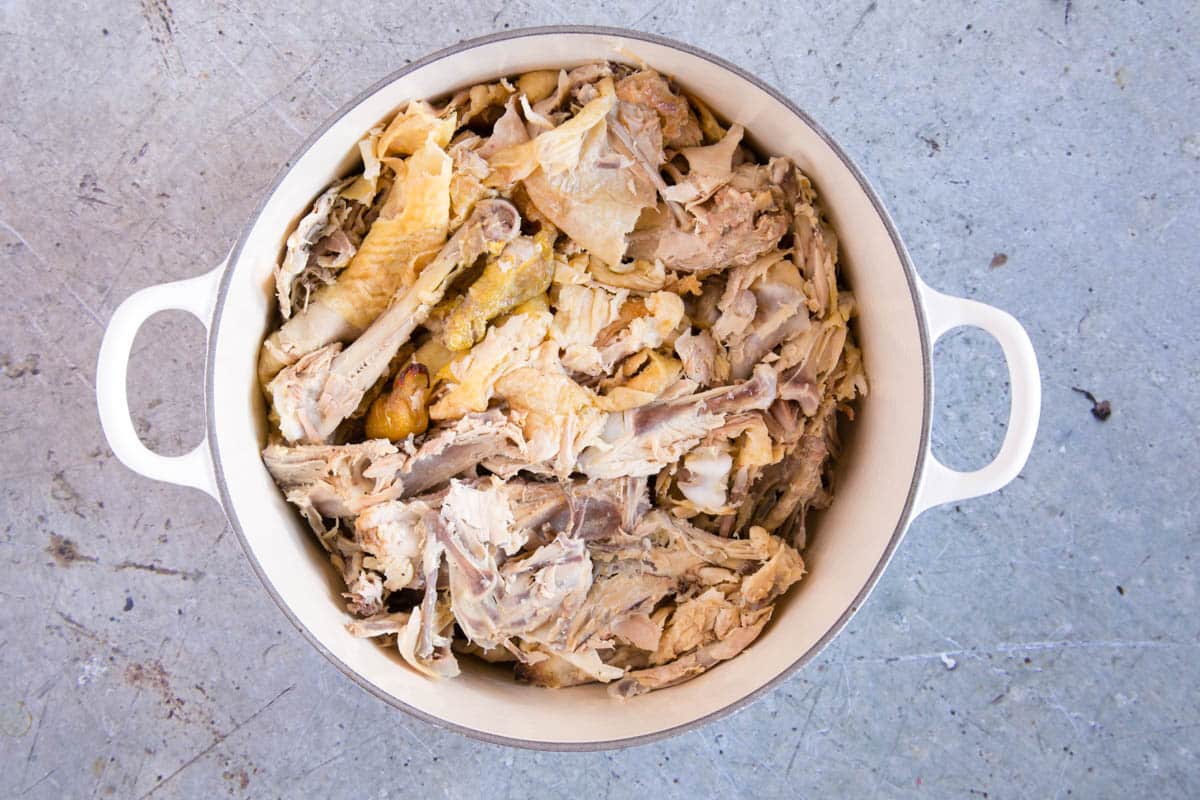
Step One – Put the chicken carcasses into a large casserole dish. Everything goes in there!
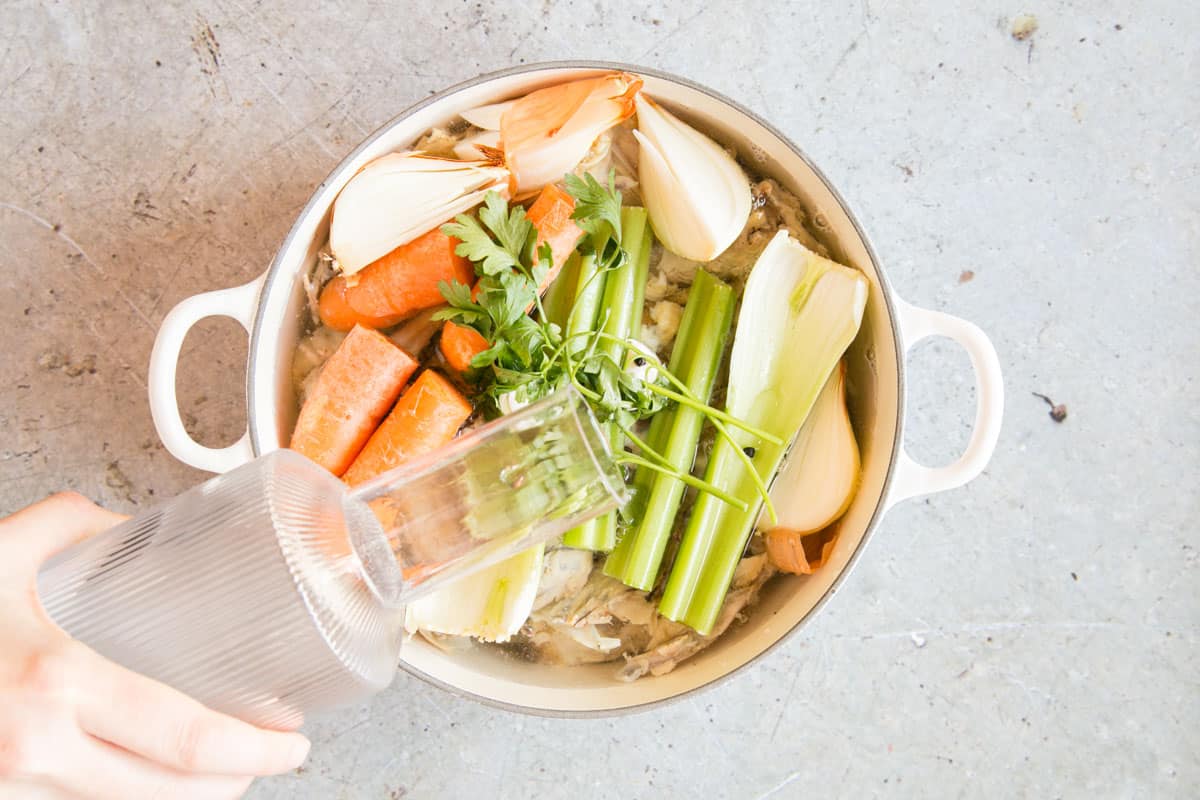
Step Two – Roughly break up the vegetables just enough that they will fit into the pot. I quarter the onions. I don’t bother to peel them, however, as you can afford to be lazy with this recipe. Put all the ingredients in the pot and top up with water, just enough to cover everything.
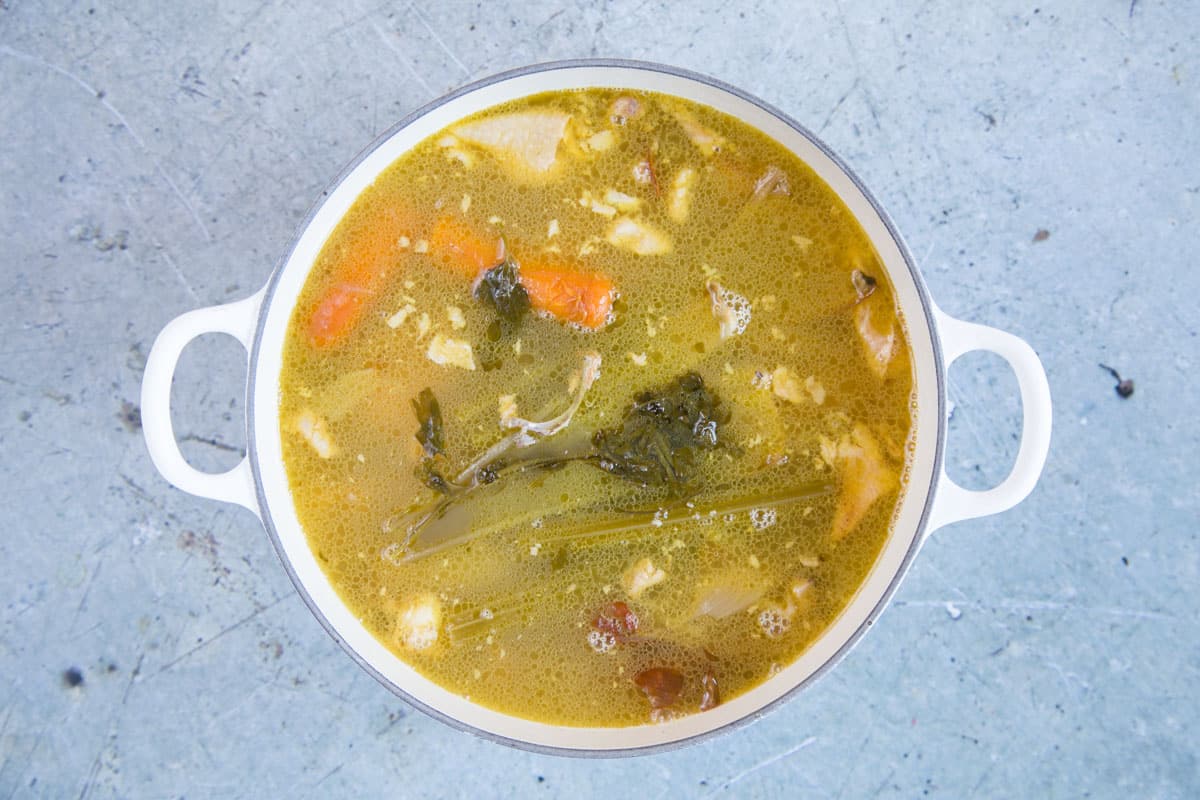
Step Three – Put the lid on and bring to the gentlest simmer, cooking for 3 hours. Alternatively, place in the oven at Gas Mark 1 for 90 minutes to 2 hours.
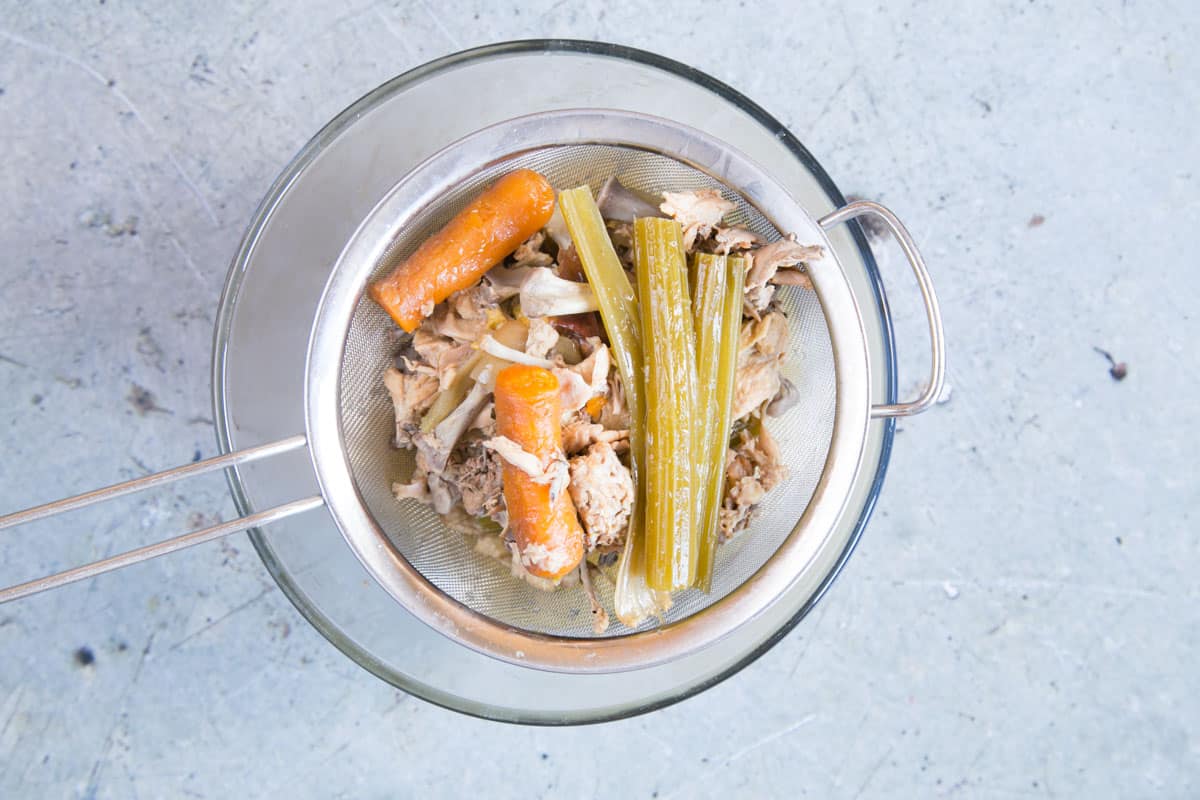
Step Four – When the broth is thick and full of flavour, ladle it into a sieve over a large bowl to strain out the solids.

Step Five – You can now decant your chicken stock into clean storage jars that have secure lids. I use a jam funnel to do this, as I find it keeps the mess to a minimum. Allow the stock to cook with the lids off.

Step Six – Once the stock has cooled, you will find that the stock is slightly jellied with a layer of fat on top. Remove this fat with a spoon (you can reserve it to cook with it as you would oil or lard – freeze it for later in a separate pot if you like).
You can now either put the lids on and store in the fridge for use within three days, or freeze without the lids, putting them in place once the stock has frozen.
How to use chicken stock
Use your chicken stock in soups, casseroles, curries and any dish that needs a good stock.
I find a pint of this homemade chicken stock is equivalent to using one stock cube made up.
Variations
- For a deeper richer flavour, roast the carcasses before making the stock. Put them in the oven at 190 °C/375 °F/Gas Mark 5 for half an hour. You can put the veg in too.
- Peel the onions if you prefer your stock to have a lighter colour.
- Add a little thyme to your stock.
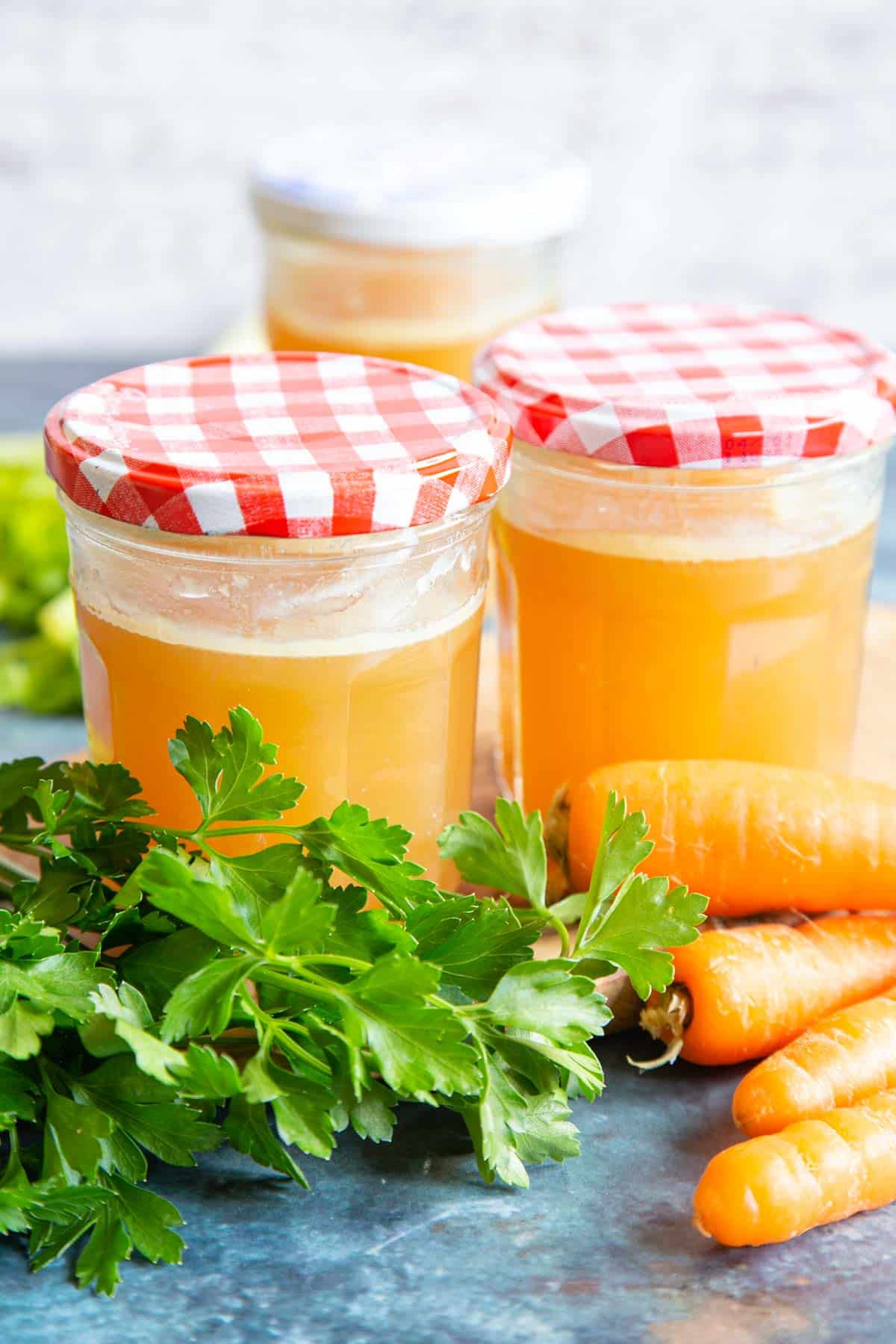
Storage
Fridge – The fresh stock can be stored in the fridge in sealed jars for three days.
Freezer – To freeze your chicken stock, stand the open jars on a tray in the freezer, ensuring that they cannot tip. Once frozen, put the lids in place. The stock will keep well for at least three months.
Hints and tips
- Don’t be tempted to skimp. You need several chicken carcasses to make stock with a good flavour.
- When stripping the carcasses to make stock, you do not need to be too picky. Leave some meat on the bones.
- Don’t skip the aromatic vegetables. They really do make a difference.
FAQs
Good homemade chicken stock is gluten free, and free of all sorts of other odd ingredients you sometimes find in commercial versions, which is just another good reason to make it.
What you are seeing is tiny particles of the ingredients that give it flavour in suspension. It’s nothing to worry about.
You can, if you are allergic. I don’t recommend it otherwise. It is such a classic part of the recipe and your stock won’t taste of celery, if you are worried because you don’t like it as a salad vegetable. You will lose some flavour, so you might want to add extra onion, parsley and carrot.
Recipes with chicken stock
- Easy slow cooker chicken curry – warming and delicious
- Leftover chicken tagine – for spicing up leftovers
- Easy Greek chicken – An easy one-pot meal
- Mustard chicken and potato one pot – a delicious rustic French-inspired dish
Classic Chicken Stock
Ingredients
- 3–4 chicken carcasses
- 2 carrots
- 1 large onion
- 2 sticks celery
- 1 clove garlic
- peppercorns (just a few)
- 1 bunch fresh parsley
Instructions
- Put the broken chicken carcasses in a good casserole dish with a lid that fits.3–4 chicken carcasses
- Break up the vegetables, quartering the onions. You don't need to peel anything. Add everything to the casserole dish and top up with enough water to cover the ingredients.2 carrots, 1 large onion, 2 sticks celery, 1 clove garlic, peppercorns, 1 bunch fresh parsley
- Put the lid on and bring to the gentlest simmer, cooking for 3 hours. Alternatively, place in the oven at Gas Mark 1 for 90 minutes to 2 hours.
- When the broth is thick and full of flavour, ladle it into a sieve over a large bowl to strain out the solids.
- You can now decant your chicken stock into clean storage jars that have secure lids. I use a jam funnel to do this, as I find it keeps the mess to a minimum. Allow the stock to cool with the lids off.
- Once the stock has cooled, you will find that the stock is slightly jellied with a layer of fat on top. Remove this fat with a spoon (you can reserve it and cook with it as you would oil or lard).You can now either put the lids on and store in the fridge for use within three days, or freeze without the lids, putting them in place once the stock has frozen.
Notes
Storage
Fridge – The fresh stock can be stored in the fridge in sealed jars for three days. Freezer – To freeze your chicken stock, stand the open jars on a tray in the freezer, ensuring that they cannot tip. Once frozen, put the lids in place. The stock will keep well for at least three months.Hints and tips
- Don’t be tempted to skimp. You need several chicken carcasses to make stock with a good flavour.
- When stripping the carcasses to make stock, you do not need to be too picky. Leave some meat on the bones.
- Don’t skip the aromatic vegetables. They really do make a difference.













ginger@dinnerdiary.org
I love the smell of chicken stock, it reminds me of Christmas!